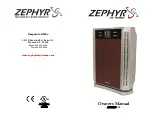
Webasto BlueCool Classic Series
TROUBLESHOOTING
27
6
TROUBLESHOOTING
6.1
Routine Checks
When starting up an air conditioning unit it is advisable to carry out a certain number of routine
checks to ensure proper functioning of the unit:
1. Always check (especially after a long absence) the functioning of the seawater cooling system.
Immediately stop the system if no seawater comes out of the pump exit after compressor start
up.
2. Periodically check the seawater strainer. Clean if necessary.
3. Periodically check the air filter in the return air grills. Clean if necessary.
4. Check condensation drain from the evaporator drain pan, take care to not damage the air-ducts.
A damaged air-duct may stop air flow through the evaporator, freeze up the evaporator and
subsequently damage the compressor.
6.2
Troubleshooting
CAUTION!
Always use genuine Webasto service and replacement parts to ensure trouble-free operation of the
AC system.
ATTENTION
Advanced troubleshooting requires comprehensive knowledge about structure and theory of operation of the
air conditioning components and should only be performed by authorized Webasto trained specialists.
1. No sign of life: check main electrical supply, fuses, etc.
2. The digital display shows 3 letters <AAA>. This means a persistent state of low voltage (less than
195 V AC for 230V units and 90V AC for 115V units). The system will restart as soon as the
voltage level climbs above cut-out level and the system will then restart after a time-delay of
1 minute approx.
3. The compressor will start but no seawater circulation can be observed:
• Check sea-cock to seawater pump.
• Check seawater strainer.
• Check if pump rotates. If the pump does not turn with the compressor working, check power
supply from the main control unit box to the pump.
4. Compressor and pump work but no correct operation in either cool or heat cycle:
• Check for proper air ventilation, blowers. If air flow completely stops with the compressor
working, the evaporator coils may freeze up completely, obstructing all air circulation.
• During the heat cycle with too slow seawater circulation you may actually freeze up the
seawater in the cupro-nickel condenser and completely block and damage the system.
• Check voltage level. Do not operate a system with a persistent voltage level below 195V AC
for 230V units and 90V AC for 115V units.
• Check refrigerant charge if operation is still not satisfactory, after having checked all the
above points.
5. The compressor works but is subject to intermittent stops without having attained the desired
setpoint temperature. The HP and LP (if present) pressure safety switches stop the compressor
because of abnormal working pressures either on the high or on the low side.
• Check for proper functioning of the cooling circuit.
• Check ventilator/blower system for obstructions.
• Check refrigerant charge (over-charge or insufficient charge level).
• Check for Error codes / interrupted system operation.
6. The heat cycle takes very long to get started. Normal if the seawater temperature is very low. If
seawater temperature drops below approx. 6 °C (43 °F) the heat cycle becomes much less
effective and takes long to get properly started.
Summary of Contents for BlueCool Classic Series
Page 38: ...THE RIGHT COOLING CAPACITY Webasto BlueCool Classic Series 38 ...
Page 39: ......














































